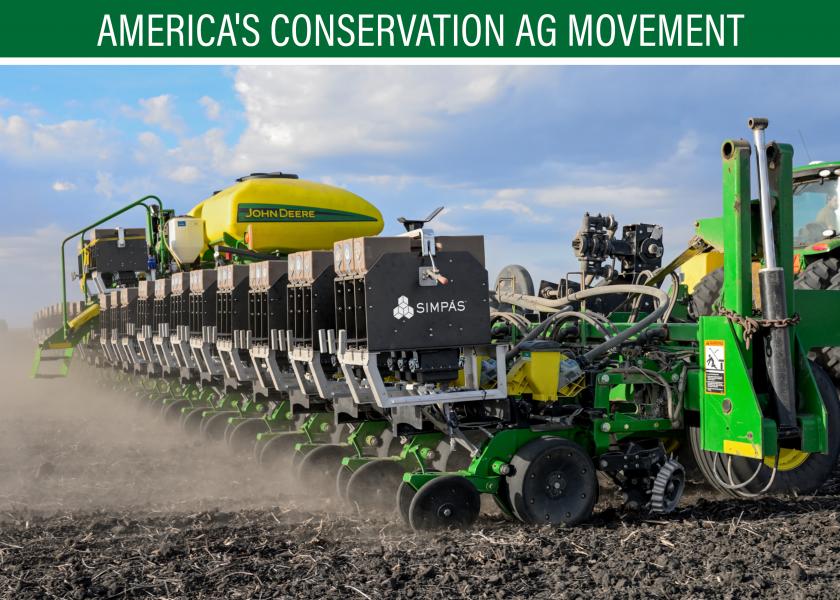Pinpoint Placement of Inputs With The Planter

For the past four years, a team has been working to develop a system that can simultaneously variable rate products at prescribed rates for in-furrow application. Not only does this method reduce inputs where they aren’t needed, it also is designed to provide full trackability and traceability of where the inputs were applied and accurately bill the farmer for exactly what was used.
This system is SIMPAS (Smart Integrated Multi-Product Prescription Application System). And in 2020, the team at AMVAC, which is currently spearheading its development, worked with five retailers to beta test the system in Arkansas, Indiana, Iowa, Minnesota and Nebraska.
“Today, we can deliver three products individually, prescriptively in the furrow,” says Caleb Schultz, Precision Ag Services Lead at AMVAC. “We can track the as-applied data just as you would seed or fertilizer.”
Schultz says this system builds on experience from AMVAC’s SmartBox system, however it uses a totally redesigned metering system. Rates can be uniform, varied and applied at very low doses for granular chemicals. There are three SmartCartridge containers on each row of the planter, and each one has 20 lb. capacity.
“We are delivering in-furrow crop protection. Farmers always want more products at planting–that’s the baseline–so this is solving a want for them,” Schultz says.
SIMPAS aims to deliver overall savings and yield enhancements with precise product placement while eliminating unnecessary applications. Schultz shares how Counter insecticide/nematicide is an example of an opportunity for effective crop protection placement at reduced total field rates.
“We can spatially sample for nematodes, and therefore we know the areas of the field with populations above established thresholds that need an application,” he says. “Right now, the application methods lead to an all or nothing proposition---and a lot of farmers choose nothing. We think SIMPAS could open a huge opportunity for effective pest control.”
In beta-tested fields, they have been able to reduce the amount of Counter applied by up to 50% in targeting applications at full rate but only in the areas needed.
“The biggest advantage to this system is its ability to deliver the exact nutrients and products where they are needed. Which is a huge message for sustainability,” Schultz says. “And we hope to grow the number of products licensed into SmartCartridge containers to be applied using SIMPAS.”
He says that is why it’s critical to get crop advisers involved so they are positioned to help farmers adopt new technology, seize opportunities to manage yield threats, and effectively spend their dollars for inputs.
The 2020 beta testing participating retailers included: Asmus Farm Supply, Harvest Land Co-op, Helena Agri-Enterprises, Nutrien Ag Solutions, and Simplot Grower Solutions. Those retailers helped AMVAC identify farmers for the beta testing, which was focused on demonstrating how field-ready the technology is.
“We really aimed for minimal hand-holding,” Schultz explains. “The idea was for the beta farmers to get adequate training and take over and run. But we were still ready to have a high-touch availability with these beta farmers—despite COVID-19. They had access to four people on our team.”
Liquid product delivery will be beta tested in 2021, which Schultz says unlocks a lot of potential particularly for crop nutrition and biological products.
“Currently, if a farmer is running 2x2 starter fertilizer and they want to use in-furrow insecticide, it has to go into the carrier solution. But our system could allow farmers to decide on a baseline fertilizer blend that is loaded in the saddle tanks and placed 2x2, and then they can use our system to customize their agronomic blend. So in-furrow they can place micronutrients and/or insecticides where they are needed.”
Delivering biologicals with the SIMPAS method eliminates the need to mix them with a carrier, keeping their efficacy intact.
Schultz says with his 10 years of experience as a precision agronomist, he sees this technology as transformative in how it helps the agriculture industry be better stewards of the land.
“This system provides a true as-applied map. Sometimes it’s hard to think of traceability on crops like soybeans and corn, but we know exactly what was applied where,” he says.
SIMPAS uses RFID-based SmartTags on each cartridge, and the RFID cards are not only readable but writable. For farmers that means easier in-field operation and product returns.
“The software writes the product application amount on the tags, so when a farmer returns a SmartCartridge container to a retailer we can issue a credit back to the farmer for the unused product,” he says. “Later, the cartridges will be weighed at our manufacturing facilities to get a final true up and ensure accurate credits.”
Additionally, efficiencies can be gained in allowing farmers to customize their applications in the field with the SmartCartridge containers rather than the retailer providing custom blends on a field by field basis.
“Operationally, if this system proliferates, you are going to see a streamline of products leaving a retail location. That provides greater flexibility to the retail agronomist and the grower, and gives operationally efficiency at the retailer,” he says.







